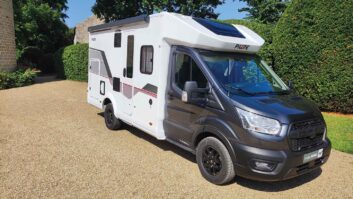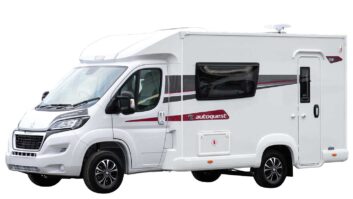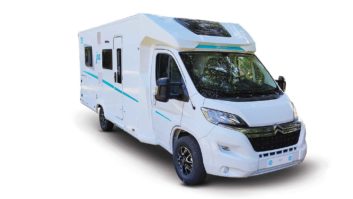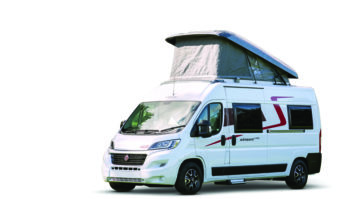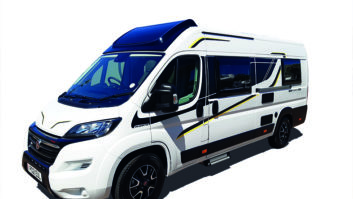Verdict
The Autoquest has an excellent dinette, the best lounge bed, very good bodywork and an attractive sub-£30,000 price, but falls short with its washroom and overcab bed.
Pros
Clever lounge design; excellent storage
Cons
Overcab bed design; washroom design
The quintessentially British end-kitchen overcab coachbuilt has many benefits – first, kitchens can be made big enough for ‘real’ cooking.
Second, kitchens never take up as much space as a fixed bed, so the ’van can remain compact while still having a roomy lounge and washroom. Finally, the mix of overcab and lounge beds means there’s room for five to sleep in comfort.
The Autoquest is based on the Peugeot Boxer 333 MWB, which uses a 2.2-litre Multijet 120 diesel engine with 100bhp and 188 lb ft of torque. It has a good, ergonomic cabin, although its handling tends to be more nose-heavy than, say, an overcab based on a Ford Transit.
All Explorer Group ’vans now bear EC Whole Vehicle Type Approval (ECWVTA), meaning they’ve passed a host of tests and met regulations governing design and safety. This has been mandatory for all new motorhomes since 2011.
Despite being less distinctive than the previous Autoquest, it still has a retro feel. Facilities are on the offside, but there’s a handy fresh water drain valve on the nearside. There’s an underslung fresh water tank, although it isn’t insulated, while the waste water tank is mounted behind the rear axle. The gas locker is helpfully close to the ground.
The door opens onto an entrance area, with the kitchen on the right and a TV stand/dresser on the left. From the door, an L-shaped corridor runs through the ’van to the cab. The flat, framed locker doors look dated compared to the latest rivals. However, it does have a light, airy interior and we loved the sturdy chrome furniture handles.
Dinettes with settees facing them are the order of the day, with comfortable cushions that should provide enough support for lounging, although perhaps not firm enough for travelling. The single-leg table clips to the wall and stows securely in the wardrobe when the lounge double bed is made up.
The windows on either side are large and provide ample natural light, and there’s a big, robust rooflight over the lounge. There’s just one power socket for the lounge, though.
There are two separate beds in the lounge, which are made up using the settee to form a single bed and the dinette to form a double. The double measures 1.81m x 0.68m. To make it you remove the lounge tables, extend the sides of the dinette seats and fill the gap between them by pulling out a slatted base from the wall. You then make up the mattress using the settee’s backrest cushion and various dinette seat cushions. Both bed designs require just one fill-in cushion.
The Autoquest’s ladder stows above the double bed rather than under it, and it’s made of fibre-board rather than aluminium. So, even though it’s the lightest, it inspires the least confidence, and its rungs lack the non-slip surface found on those in the other motorhomes. The Autoquest’s bed presents problems, too: to let the bed raise, the mattress is split in the middle, and in our test motorhome one half was 2cm thinner than the other. At least it’s a large bed, at 2.05 x 1.43m.
The Autoquest has a roomy kitchen with ample storage areas and lots of light, thanks to a fluorescent fixture over the sink and a good-sized rear window. There’s no extractor fan, so the window will be needed for ventilation. There’s a three-burner hob and a small oven and grill unit conveniently located at around knee level. Despite the large sink, there’s ample workspace available.
Unfortunately, the cutlery drawer is in a tall cupboard just by the entrance door, but you can’t open this cupboard door fully because of the entrance door handle. In turn, that means the cutlery drawer can’t slide out all the way.
Essentially, the washroom is a featureless white capsule, with a fixed bench toilet rather than a swivelling one and only a curtain to cordon off the shower. The mirror is divided into two halves that open to reveal a useful cabinet. We were a bit concerned about the right half, though, because if not secured it can easily swing open and strike the towel ring, causing the mirror to break.
There are impressive amounts of storage under the settee, but without a door on the outside. However, it does have a strut to hold up the settee base when you need access to it. Despite the large amounts of locker and cupboard space, we had to deduct points for having no shelves in any overhead lockers.
Blown-air heating is available only as an option. Otherwise, the equipment levels are good enough for the Autoquest to be used straight out of the box.
Technical Specifications
| Payload | 539 kg |
| MTPLM | 3300 kg |
| Shipping Length | 6.32 m |
| Width | 2.20 m |


